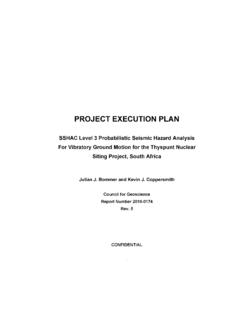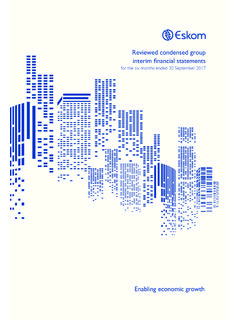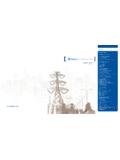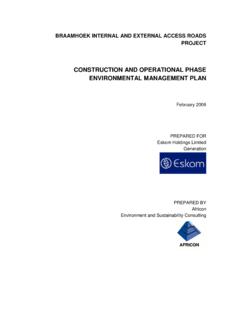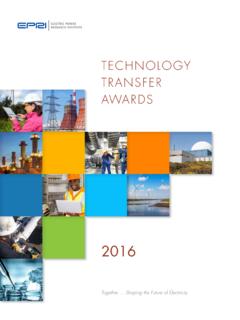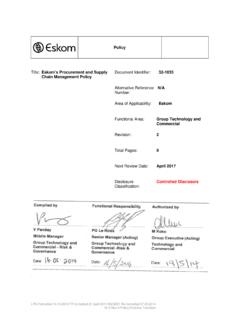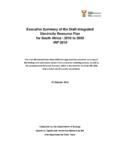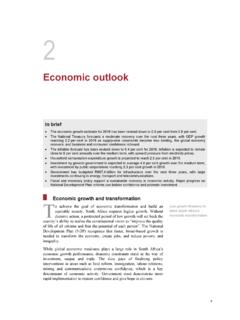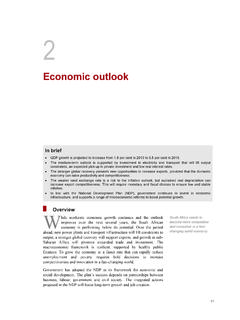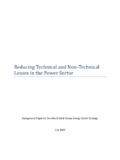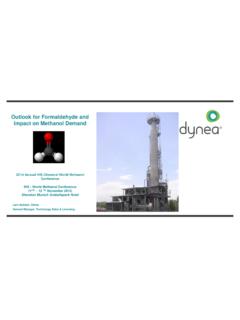Transcription of and pricing in South Africa - Eskom
1 An overview of electricity consumption and pricing in South Africa An analysis of the historical trends and policies, key issues and outlook in 2017 Report prepared for Eskom Holdings SOC Ltd Date: 24 February 2017 1 Disclaimer This Report is prepared by Deloitte Consulting Pty (Ltd). Deloitte who was engaged by Eskom Holdings SOC Ltd. Eskom . Deloitte does not accept any duty of care, to any other person or entity other than Eskom . The Report has been prepared for the purpose set out in the Engagement Letter between Deloitte and Eskom . Deloitte understands that Eskom will potentially provide a copy of this Report to the National Energy Regulator of South Africa (NERSA) in support of their upcoming tariff application. We agree that a copy of our Report can be provided to NERSA and also released publicly on the basis that it is published for general information only and that we do not accept any duty, liability, or responsibility to any person (other than Eskom ) in relation to this Report.
2 Recipients of this Report should seek independent expert advice as this report was not prepared for them or for any other purpose than that detailed in the engagement terms with Eskom and cannot be relied upon other than for this. This report is based largely on publically available information. We have not audited the information, nor do we provide any assurance on the underlying information or the analysis thereof. Information contained in the Report is current as at the date of the Report, and may not reflect any event or circumstances which occur after the date of the Report. An overview of electricity consumption and pricing in South Africa | Contents 2 Contents Contents .. 2 List of Tables .. 3 List of Figures .. 4 Executive Summary .. 5 Introduction .. 15 1. electricity consumption in South Africa composition, key drivers, and the outlook.
3 18 Introduction .. 18 Analysis of the structure of the SA 18 National electricity consumption by sector .. 19 Key drivers of electricity demand .. 22 Drivers of electricity demand in South 25 Review of Eskom sales forecast variance for MYPD3 period .. 31 Outlook for electricity consumption .. 33 Conclusions .. 36 2. Trends in electricity prices a critical review of historical pricing policy and decisions .. 38 Introduction .. 38 Historical trend in electricity prices .. 38 History of electricity pricing in South Africa .. 41 Critical review of government s policy of subsidising electricity .. 46 Key considerations not adequately addressed in recent regulatory decisions on electricity tariffs .. 50 Key findings and conclusion .. 52 3. International competitiveness of South African electricity tariffs.
4 55 Introduction .. 55 The structure of the electricity supply industry and implications for tariff-setting and benchmarking .. 55 International comparison of electricity prices .. 59 Conclusion .. 63 4. Requirements of an efficient electricity pricing regime .. 65 Introduction .. 65 Requirements of an effective electricity pricing regime .. 65 Additional requirements for a monopoly utility that is consistent with efficient delivery of electricity services.. 70 Support for the transition to cost-reflective electricity prices in South Africa .. 72 What is the gap between actual and cost-reflective electricity tariffs in South Africa ? . 73 Support for the transition to cost-reflective electricity prices in the SADC region .. 74 Barriers to the removal of electricity subsidies and strategies for reform.
5 75 Some specific guidelines for the successful removal of electricity price subsidies in South Africa to support a transition to cost-reflective prices .. 77 Conclusion .. 79 Reference List .. 81 An overview of electricity consumption and pricing in South Africa | List of Tables 3 List of Tables Table 1: Price elasticities of electricity demand , 2002-2007 vs. 2008 to 2012 .. 28 Table 2: electricity intensity - South Africa and Rest of World (GWh/PPP adj. $ million) 1971-2010 .. 30 Table 3: Eskom customer segmentation and tariff plans .. 57 Table 4: NERSA guidelines on determination of Tariff increases 2015-2016 .. 58 Table 5: South Africa s performance in the NUS ranking of countries electricity prices, 2011 to 2015 .. 61 An overview of electricity consumption and pricing in South Africa | List of Figures 4 List of Figures Figure 1: Evolution of the South African economy, 1975 - 2015.
6 19 Figure 2: electricity consumption by sector, 2012 .. 20 Figure 3: Trend in electricity consumption by customer category, 1993-2013 .. 21 Figure 4: Estimates of the electricity intensity of selected sectors, 2012 .. 22 Figure 5: Historical trend in electricity sales in South Africa , GWh, 1996 to 2016 .. 25 Figure 6: Relationships between growth in real GDP and electricity consumption (GWh), 1997 to 2016 .. 26 Figure 7: Price and income elasticity of electricity demand in South Africa , 1986 to 2005 .. 27 Figure 8: Trend in the electricity intensity of the SA economy vs. real electricity prices, 1980 to 2016 .. 29 Figure 9: Contribution of output, structural changes, and efficiency to total electricity consumption (1993 to 2006) .. 31 Figure 10: Eskom MYPD3 sales volume variance - forecast vs. actual.
7 32 Figure 11: GDP and Eskom sales growth variance - forecast vs. actual .. 33 Figure 12: Real GDP and Eskom s SA electricity sales historical and 5-year 34 Figure 13: electricity intensity of the SA economy, historical and forecast .. 35 Figure 14: Trend in Average electricity Prices realised by Eskom per kWh (1973 to 2015/16) .. 40 Figure 15: Composition of Eskom sales by customer category, 2014/15 .. 56 Figure 16: Variation in the standard residential active charge tariff (R/kWh)1 levied by selected municipalities and Eskom , 2015/16 .. 59 Figure 17: International comparison of the price of electricity delivered in June 2015, NUS Survey .. 60 Figure 18: International comparison of electricity tariffs for industrial consumers ($US/kWh) .. 62 Figure 19: International comparison of electricity tariffs for residential consumers ($US/kWh).
8 63 Figure 20: Effect of lumpy investments on prices set at short-run marginal cost .. 67 Figure 21: Tariff formula Eskom s allowable revenue .. 68 Figure 22: Iterative feedback loop for price setting .. 71 Figure 23: Size of the gap between actual and cost-reflective tariff in 2014/15 .. 73 An overview of electricity consumption and pricing in South Africa | Executive Summary 5 Executive Summary I. Purpose of the study This report was commissioned by Eskom as part of its preparation for its fourth Multi-Year Price Determination (MYPD4) tariff application. The overall objectives of this report are: To provide stakeholders with a broad historical context of electricity prices and consumption ahead of the forthcoming tariff application. To highlight some of the main criticisms of electricity pricing policy in South Africa and the key issues Eskom and the regulator face.
9 To discuss the requirements of an efficient electricity pricing regime and the economic principles that underpin the setting of equitable and efficient tariffs under a regulated and vertically-integrated monopoly provider. To examine the international competitiveness of electricity prices in South Africa . To provide both general and specific guidelines and strategies for the successful removal of electricity price subsidies in South Africa , in support of a gradual transition to cost-reflective prices. The report updates and expands on analysis that was commissioned by Eskom ahead of its MYPD3 application in 2012, titled The economic impact of electricity price increases of various sectors of the South African economy (Deloitte, 2012). II. Key findings and recommendations The report is structured around four chapters and the key findings of the report have been summarised, by chapter, below.
10 I. Chapter One: electricity consumption in South Africa composition, key drivers, and the outlook The purpose of this chapter is to provide an overview of the historical trends in electricity consumption in South Africa , the changing composition of electricity sales by sector, key determinants of demand , methods of decomposing demand , and a brief analysis of the medium-term energy demand outlook. The relatively energy-intensive mining and manufacturing industries are the dominant consumers of electricity in South Africa they account for roughly 60% of national consumption but only 22% of GDP. An overview of electricity consumption and pricing in South Africa | Executive Summary 6 Despite the steady decline in the combined contribution of manufacturing and mining sector to GDP (from 31% of GDP in 1995 to 22% in 2015), these sectors are still responsible roughly 60% of total national electricity consumption.
